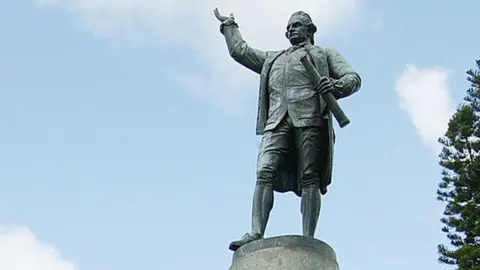Australia debates Captain Cook 'discovery' statue
 Getty Images
Getty ImagesA debate has ignited in Australia over a statue of British explorer Captain James Cook, which has a plaque saying he "discovered this territory".
The 19th Century statue, in Sydney's central Hyde Park, has come under scrutiny following recent discussion over Confederate monuments in the US.
Critics say the inscription overlooks indigenous Australians, while others defend it as being part of history.
Sydney's city council says it will seek advice on the issue.
Lord Mayor Clover Moore said she had referred the debate to an Aboriginal and Torres Strait Islander advisory panel.
When was the statue built?
The monument was installed more than a century after Capt Cook arrived in Australia in 1770, later claiming the region for the British crown.
Funded by the New South Wales government and members of the public, the statue was completed by English sculptor Thomas Woolner and unveiled in front of a huge crowd in 1879.
It bears inscriptions marking Capt Cook's birth and death, but it is the south-facing engraving - "Discovered this territory 1770" - which has caused controversy.
What is the criticism?
The Australian Broadcasting Corporation's indigenous affairs editor, Stan Grant, wrote an article on Friday arguing that "surely we need no longer maintain the fiction that he [Capt Cook] 'discovered' this country".
Grant said that the inscription should be changed. He argued that some other indigenous people favoured removing the statue.
Referring to a comment by PM Malcolm Turnbull about honouring indigenous Australians, Grant wrote: "If he is serious then what could be more apt than to correct a monument that tells us, still, that in 1770 we did not exist?"
His argument has provoked much national discussion, and has received support, particularly on social media.
Grant wrote the column following violent clashes in Virginia earlier this month and debate about America's racial legacy.
How is it being defended?
In a column for The Australian, historian Keith Windschuttle wrote that the inscription was "perfectly accurate" if the word "territory" was defined as the east coast of Australia.
"Cook was in fact the first person in history to traverse the whole of this coastline and view its 2,000 miles (3,200km) of shores and hinterland," he wrote, describing the debate as "wanton provocation".
 Getty Images
Getty ImagesOthers have suggested keeping the monument but finding better ways to publicly acknowledge indigenous Australians.
"What is wrong with telling both stories, rather than rewriting history and obliterating a plaque to James Cook?" one commentator, Tim Webster, told Channel Seven.
What does Sydney's council say?
Ms Moore said the issue would be discussed by its indigenous advisory board before the council took any position.
"There have been too many people in mainstream Australia ready to make judgement on these issues without consulting indigenous communities, and whether well-meaning or not, it's often done more harm than good," she said in a statement to the BBC.
She said the council had undertaken several initiatives to recognise indigenous culture.
Is this an isolated debate?
No, discussion about how to better recognise Aboriginal and Torres Strait Islander Australians has stepped up in recent months.
In May, a landmark summit of indigenous leaders called for a formal representative body in parliament and a pathway to a treaty.
The national Australia Day celebration, an anniversary of the arrival of Britain's First Fleet, has also sparked controversy.
Two Melbourne councils in the last week have voted - one unanimously - to shift their celebrations over indigenous cultural sensitivities.
